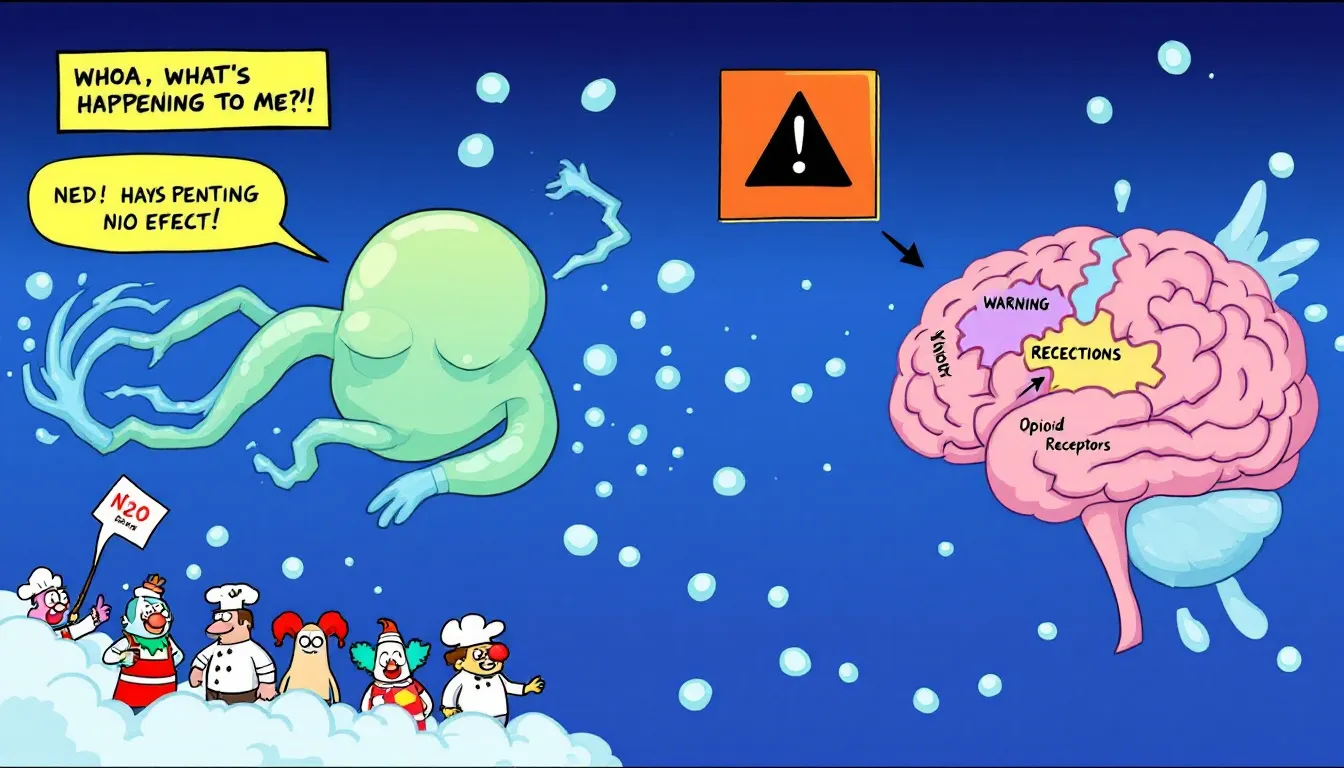
How Does Nitrous Oxide Work in Medical Procedures? | N2O Filters
Key Takeaways
Nitrous oxide is a potent inhalational anesthetic, providing rapid analgesia and sedation in medical and dental procedures by inhibiting NMDA receptors and activating GABA-A receptors.
Safe administration of nitrous oxide requires careful monitoring, proper ventilation, and adherence to contraindications to minimize potential risks and adverse effects.
Effective patient education and interprofessional coordination enhance the safety and efficacy of nitrous oxide use, improving overall healthcare outcomes and patient satisfaction.
Understanding Nitrous Oxide

Nitrous oxide, widely recognized as laughing gas, is an invisible and non-flammable substance with a simple chemical composition of N2O. Renowned for its significant role in both medical and dental anesthesia, this powerful inhalational agent offers pain relief and mild sedation which are essential during a variety of medical and dental interventions. Its ease of administration along with its swift effectiveness has solidified nitrous oxide’s prominent position amongst anesthetic gases.
Referred to in clinical settings as “laughing gas,” the euphoric state it induces adds to its appeal among healthcare providers. It effectively diminishes both discomfort and anxiety for patients undergoing procedures ranging from routine tooth extractions to complex surgical operations. Nitrous oxide remains a preferred choice within practices due to the enhanced safety profile and comfort it provides during patient treatment experiences.
Mechanism of Action
The effectiveness of nitrous oxide in medical treatments is attributed to its complex mode of action. It engages with different neural pathways, notably by hindering the activity of NMDA receptors while simultaneously stimulating GABA-A receptors. These interactions give rise to both anesthetic and anxiety-reducing effects, which account for why nitrous oxide is such a valuable resource during various medical and dental procedures.
By blocking NMDA receptors, nitrous oxide diminishes the sensation of pain. At the same time, it induces relaxation by engaging GABA-A receptors—a combination that contributes to what is known as nitrous oxide antinociception. Through these mechanisms, patients experience not just relief from discomfort, but also a sense of tranquility.
To fully grasp how nitrous oxide operates, it requires analyzing its engagement with several receptor types: opioid systems alongside benzodiazepine and GABA receptors are explored. To considering how it suppresses NMDA receptor activities—each contributing uniquely to our understanding of this gas’s functionality within clinical applications.
Interaction with Opioid Receptors
The pain-relieving effects of nitrous oxide are achieved through its interaction with opioid receptors situated in the periaqueductal gray region of the midbrain. This mechanism mirrors that of morphine, as it triggers the discharge of endogenous opioids which then bind to these receptors. Upon administration, nitrous oxide prompts the generation of endogenous opioid peptides that act on opioid receptors to offer substantial relief from discomfort.
A key element in this process is nitric oxide as it instigates neurons to release dynorphins, amplifying the analgesic impact imparted by nitrous oxide. Nitric oxide’s regulatory function over dynorphin secretion highlights an intricate connection between both molecules when addressing effective pain control.
Notably, naloxone — an antagonist for opioid receptors — can obstruct the pain-reducing effect yielded by nitrous oxide. This demonstrates that such analgesic influence hinges on activation within opioid receptor sites.
GABA and Benzodiazepine Receptors
The anxiolytic effects of nitrous oxide are induced by the stimulation of GABA-A receptors, which play a role in the central nervous system’s inhibitory functions. This leads to an enhanced flow of chloride ions into neurons, causing hyperpolarization and a subsequent decrease in neuronal excitability.
Nitrous oxide stimulates the benzodiazepine binding site found on GABA-A receptors. This action supports GABA activation and promotes additional influxes of chloride ions. The process bears resemblance to that by which benzodiazepines produce their calming effects, resulting in pronounced anxiolytic outcomes.
There is a close link between the brain’s mechanisms involving benzodiazepines and the soothing effects produced by nitrous oxide. As such, building up tolerance to benzodiazepines might also lead to diminished sensitivity towards the anxiety-reducing responses elicited by nitrous oxide due to cross-tolerance phenomena.
NMDA Receptor Inhibition
The anesthetic effects of nitrous oxide can be traced to its non-competitive inhibition of NMDA receptors. These receptors play a pivotal role in the synaptic transmission within the central nervous system. When nitrous oxide hampers their activity, there’s a noticeable decrease in both pain sensation and overall sensory processing. This action is Evidenced by diminished visual evoked potentials, underscoring its profound impact on functions of the central nervous system.
By diminishing synaptic transmission through the blocking of NMDA receptors, nitrogen oxide serves as an effective agent for providing anesthesia. Its ability to alleviate pain and induce sedation makes it particularly useful during various medical procedures.
Grasping these complex interactions sheds light on how critical nitrous oxide is within healthcare environments due to its diverse clinical applications.
Administration Techniques

When administering nitrous oxide, it’s essential to prioritize safety and effectiveness. This is typically achieved through inhalation methods such as using a face mask, laryngeal mask airway, or endotracheal tube. The administration begins with 100% oxygen and then transitions to a blend of 30-50% nitrous oxide in order to attain the desired analgesic and anxiolytic impacts. Incrementally increasing the concentration of nitrous oxide can help reduce hypoxia risks along with other potential complications.
In areas where nitrous oxide is utilized, ensuring proper ventilation alongside waste gas scavenging systems are crucial for maintaining a safe environment. Equally important is effective communication regarding potential hazards involved with its use. Implementing an inline oxygen analyzer equipped with an alarm system is also critical in averting the delivery of hypoxic mixtures.
Utilizing a pin-index safety system during nitrous oxide setup helps prevent incorrect connections of gas cylinders while ASA standard monitoring remains indispensable for safeguarding patient well-being throughout this medical procedure.
Nitrous Oxide Oxygen Administration
It is essential to mix nitrous oxide with oxygen when aiming for a secure and effective procedural sedation. This practice reduces the likelihood of hypoxia along with other potential issues, providing an equilibrium in sedative effect. A nasal mask often delivers nitrous oxide in conjunction with oxygen to sustain an appropriate mixture that wards off the risk of depriving the body of oxygen.
Administering a 50% blend of nitrous oxide mixed with oxygen yields successful analgesic results from the gas. In urgent situations, swift application of this concoction can offer both sedation and relief from discomfort promptly, affording patients ease and stability as they await additional medical intervention.
This technique for delivering medication boasts efficiency as well as safety, garnering favorability across various healthcare settings due to these advantages.
Self-Administered Nitrous Oxide
Patients have the opportunity to personally manage their pain relief during medical procedures by using self-administered nitrous oxide. Healthcare professionals can continue to communicate verbally with patients, allowing them to monitor comfort levels and modify nitrous oxide dosages when necessary. This method empowers patients by giving them control over their pain management, thereby improving their experience and satisfaction.
With the ability to tailor the amount of nitrous oxide they receive based on how much discomfort they feel, patients benefit from a customized and adaptable approach to pain control. The use of self-administered nitrous oxide has been known to heighten patient contentment while simultaneously diminishing anxiety, which contributes to its desirability as an option for various medical and dental procedures.
Applications in Dentistry

Nitrous oxide is a critical component in the realm of dentistry, especially for alleviating pain and anxiety during dental treatments. Its dual capability to provide analgesia as well as sedation renders it an essential instrument for those in the dental profession. Patients inhaling nitrous oxide often feel euphoric and exhibit slower respiration rates, aiding in creating a calmer and more pleasant atmosphere for receiving dental care.
The careful application of nitrous oxide within dental practices contributes to increased patient contentment and diminished apprehension. By lessening discomfort and fear, it permits more proficient and efficacious execution of dental procedures. This is particularly advantageous when treating pediatric patients who are prone to greater levels of stress when attending dentist appointments.
Pediatric Dental Patients
Nitrous oxide has revolutionized dental visits for pediatric patients by improving their ability to relax and cooperate. Its use in children leads to decreased stress during appointments and a smoother experience overall. By relaxing dentin and collagen within the teeth, it also lessens tooth sensitivity and diminishes fear, which contributes positively to the dental experiences of young individuals.
The serene and discomfort-free atmosphere created by nitrous oxide allows pediatric dentists to carry out procedures with greater ease. This not only benefits the young clients, but also streamlines the work for dental staff, leading to an enhancement in the quality of dental care provided.
Dental Office Safety
Maintaining safety in dental offices where nitrous oxide is utilized is crucial. It’s important to avoid its use in cases of extreme nasal congestion, individuals who predominantly breathe through their mouth, and those who are unable to tolerate a nasal mask. By observing these precautions, the safety of patients can be secured while reducing associated risks.
In ensuring a safe environment for administering nitrous oxide, dental professionals have a critical responsibility. They must diligently screen for any contraindications before treatment and adhere strictly to established safety protocols. This vigilance safeguards patient health as well as enhances the effectiveness of nitrous oxide applications.
It’s imperative that appropriate air circulation systems and methods for eliminating waste gases are in place within dental settings. Such measures are necessary to safeguard both patients and staff from the harmful effects that may arise from exposure to nitrous oxide.
Medical and Surgical Uses
Nitrous oxide serves a vital role beyond the confines of a dental practice, being employed in an array of medical and surgical interventions to alleviate pain and anxiety. Its swift action paired with straightforward application renders it an indispensable resource in emergency medical situations that demand prompt and proficient management of discomfort. Employing nitrous oxide effectively in such scenarios can help decrease patient recovery periods, thereby improving overall outcomes after treatment.
During operative procedures, nitrous oxide anesthesia augments other sedatives by offering additional calming effects and analgesia. This versatile agent is fundamental across various levels of medical treatments ranging from simple to complex operations due to its dual capability for both easing pain and inducing relaxation — bolstering the effectiveness of sedation techniques utilized throughout these processes.
Obstetric Analgesia
Within the field of obstetrics, there has been a growing trend in using nitrous oxide as an effective and reliable form of pain relief during labor. Since its introduction in 2011, numerous U.S. birthing facilities have started to offer nitrous oxide to their patients. It plays a significant role in lessening the mother’s experience of discomfort throughout childbirth, thereby making it more bearable and reducing anxiety.
Research supports that employing nitrous oxide for managing pain while giving birth is secure for both mothers and newborns without causing considerable negative outcomes. The adoption of this method often leads to heightened contentment among patients and can even result in shortened lengths of labor due to its analgesic effects. Consequently, expectant women who are looking for effective solutions for pain control during delivery find nitrous oxide an appealing choice.
Emergency Medical Care
Nitrous oxide is an essential component of emergency medical care, serving as a key agent for analgesia and sedation due to its swift action and simplicity in handling. This makes it exceptionally suited for the quick management of acute pain and distress encountered in such settings. Individuals with severe cardiac disease or pulmonary hypertension should not be administered nitrous oxide, as these are clear contraindications.
When contemplating the use of nitrous oxide under certain conditions, caution must be exercised since they are considered relative contraindications. It’s imperative to administer nitrous oxide combined with oxygen during emergencies to enhance patient safety and minimize potential risks like respiratory depression and postoperative nausea.
Employing nitrous oxide effectively in emergency situations can offer immediate relief from discomfort and anxiety. It also aids in stabilizing patients while preparations are made for subsequent treatment procedures.
Potential Side Effects and Risks

Nitrous oxide is typically safe to use. It can cause temporary side effects and carry certain risks. Patients may experience mild but bothersome issues such as headaches, agitation, nausea, and dizziness during or following the procedure. These adverse effects tend to be short-lived.
When used in confined areas without sufficient airflow, nitrogen oxide has the potential to elevate gas volume and pressure within that space. To reduce the likelihood of complications arising from this increase in pressure and volume, it is essential to keep a close watch on its use and ensure adequate ventilation is present at all times. The careful management of these possible side effects is key for maintaining safety when utilizing nitrous oxide in dental practices or medical environments.
Short-term Adverse Events
Nitrous oxide is linked to several short-term negative reactions such as:
feelings of nausea
the act of vomiting
bouts of coughing
sensations of dizziness
Patients commonly experience postoperative nausea and vomiting following nitrous oxide administration. Although these side effects are mild, they can still be quite uncomfortable for patients and must be managed effectively.
Additional adverse events may include symptoms like feeling faint or actually losing consciousness, which are more likely in individuals who react strongly to nitrous oxide. When used concurrently with other sedatives, nitrous oxide has the potential to increase respiratory depression, making vigilant supervision necessary during its application. Some patients might experience temporary agitation as a side effect. Ongoing patient monitoring is imperative.
Long-term Exposure Risks
Long-term health risks are associated with chronic occupational exposure to nitrous oxide. Continuous inhalation of this substance can disrupt the body’s processing of vitamin B12 and folate, potentially leading to grave medical conditions. Among these is megaloblastic anemia accompanied by neurological issues that arise due to extended periods of exposure.
A rare yet severe condition known as subacute combined degeneration (SACD) may also occur following persistent nitrous oxide exposure, affecting the spinal cord. The potential for such long-term effects highlights the critical need for adequate ventilation and adherence to safety practices in places where there is regular use of nitrous oxide.
It remains crucially important to protect both patients and healthcare professionals from harm by maintaining their health and safety in settings prone to nitrous oxide exposure.
Contraindications and Precautions
Prior to the administration of nitrous oxide, it is essential to evaluate any contraindications and safety measures in order to avert adverse events. Absolute contraindications encompass various conditions such as:
Profound cardiac disease
Early pregnancy (first trimester)
Presence of pneumothorax
Obstruction within the small intestine
Operations involving the middle ear
Procedures related to retinal surgery
These specific health issues can significantly elevate the likelihood of experiencing complications from nitrous oxide and must be diligently avoided.
Individuals suffering from respiratory infections should also refrain from using nitrous oxide due to potential exacerbation of their condition. It’s vital for patients to receive information about both positive and negative effects associated with nitrous oxide use. This ensures they provide informed consent and remain at ease during medical interventions.
Ensuring patient safety when administering nitrous oxide necessitates thorough screening processes along with comprehensive education regarding its usage.
Absolute Contraindications
Absolute contraindications to the use of nitrous oxide include severe airway obstruction, any condition that adversely affects respiratory or cardiovascular function, and pulmonary hypertension due to the heightened risk of adverse effects.
Specifically, using nitrous oxide in cases of pulmonary hypertension can substantially elevate complication risks. It is imperative for patient safety and the proper application of nitrous oxide in clinical environments that these contraindications are strictly observed.
Relative Contraindications
Certain conditions are considered relative contraindications for the use of nitrous oxide, such as:
Previous stroke incidents
Low blood pressure
Established heart conditions
Patients in a critical health state
Serious mental health disorders
People suffering from high blood pressure in the lungs
Patients with these issues should receive nitrous oxide with increased care.
Individuals who have previously abused substances may face greater danger when exposed to nitrous oxide. Vigilant observation and careful assessment are crucial during the administration of nitrous oxide to protect patients and reduce possible hazards.
Enhancing Healthcare Outcomes
Collaborative efforts and effective communication between healthcare professionals are crucial for the optimal administration of nitrous oxide, which leads to enhanced patient outcomes. Working together increases safety and reduces risks related to its use, providing patients with superior care.
It is also essential to educate patients regarding nitrous oxide by discussing both its advantages and possible adverse effects. This knowledge empowers them to make well-informed choices and helps alleviate any discomfort they may have about undergoing procedures involving this gas. A deeper understanding on the part of the patient fosters greater adherence to treatment protocols and satisfaction, thereby advancing overall healthcare results.
Interprofessional Coordination
Ensuring the safe and effective application of nitrous oxide during medical procedures relies heavily on the collaborative efforts of interprofessional healthcare teams. When these diverse professionals work in concert, it enhances patient outcomes while reducing the potential hazards linked to administering nitrous oxide.
The implementation of thorough safety measures is essential in settings where nitrous oxide is employed, safeguarding patients as well as healthcare staff from any risks posed by exhaled gas. A united and cooperative approach among health practitioners is crucial for maximizing the benefits derived from nitrous oxide usage, guaranteeing superior care for their patients.
Patient Education
Informing patients about the use and implications of nitrous oxide can increase their comfort level and cooperation throughout dental treatments. When healthcare providers offer thorough explanations, it helps reduce patient stress and leads to a better procedural experience.
This is especially true for children undergoing dental care, as they often have heightened fears about such procedures. Stressing the importance of adequate air circulation and safety protocols is crucial to create a secure and efficient setting for administering nitrous oxide. Patient education plays an essential role in achieving favorable results with nitrous oxide use in dentistry.
Summary
To encapsulate, nitrous oxide serves as a highly versatile and efficient agent utilized in numerous medical and dental procedures. Its capacity to induce both pain relief and sedation is essential across diverse clinical scenarios. Grasping the functional dynamics, methods of administration, and possible adverse reactions associated with nitrous oxide is imperative for its secure and efficacious application.
Ensuring adherence to established safety guidelines, recognizing contraindications along with necessary precautions, cultivating collaborative efforts among healthcare professionals, as well as educating patients about the substance, are all pivotal steps toward enhancing the utility of nitrous oxide. It maintains a crucial position within contemporary medicine by providing an accessible means for managing pain and alleviating anxiety effectively.
Frequently Asked Questions
What is nitrous oxide, and how is it used in medical procedures?
Often called laughing gas, nitrous oxide is a colorless and odorless substance employed for its analgesic and calming properties.
During different medical and dental procedures, it is breathed in to alleviate discomfort and reduce anxiety.
How does nitrous oxide work to relieve pain and reduce anxiety?
Nitrous oxide mitigates both pain and anxiety through the suppression of NMDA receptors and the stimulation of GABA-A receptors, which results in analgesic and anxiolytic outcomes.
It triggers opioid receptors to augment analgesia by prompting the release of endogenous opioids.
What are the common side effects of nitrous oxide?
Nausea, vomiting, dizziness, and headaches are frequent side effects associated with nitrous oxide use. Prolonged exposure can interfere with the metabolism of vitamin B12 and folate, which may lead to megaloblastic anemia as well as neurological problems.
Are there any contraindications for using nitrous oxide?
Yes, nitrous oxide has absolute contraindications such as severe cardiac disease, first trimester of pregnancy, pneumothorax, and certain surgeries like those involving the middle ear and retina.
Additionally, conditions such as a history of stroke and known cardiac issues are considered relative contraindications.
How can healthcare providers ensure the safe use of nitrous oxide?
By sticking to rigorous safety measures, such as adequate ventilation and effective scavenging of waste gases, healthcare providers can maintain the safe administration of nitrous oxide. It’s also important for them to keep a close watch on patients throughout its use.
It is essential to inform patients adequately about the procedures involving nitrous oxide and foster collaboration among various healthcare professionals to reduce any potential hazards linked with its application.






Leave a comment
This site is protected by hCaptcha and the hCaptcha Privacy Policy and Terms of Service apply.